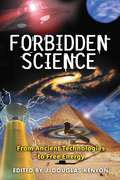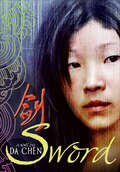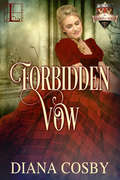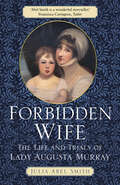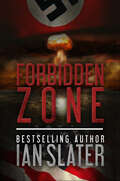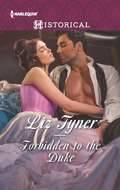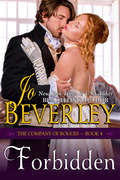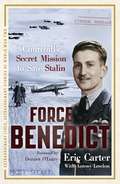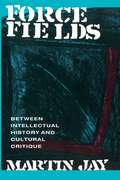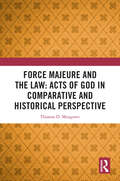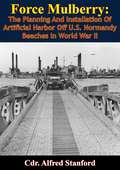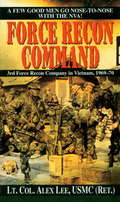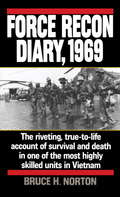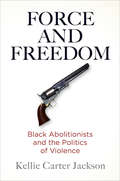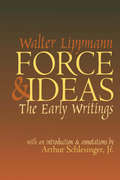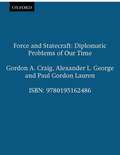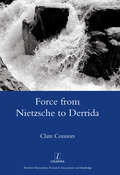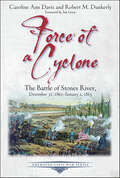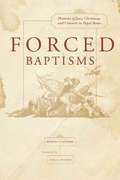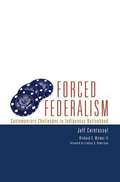- Table View
- List View
Forbidden Science: From Ancient Technologies to Free Energy
by J. Douglas KenyonReveals the cutting edge of New Science and shows how established science disallows inquiry that challenges the status quo--even when it produces verifiable results • Contains 43 essays by 19 researchers denoting cutting-edge, heretical, or suppressed scientific research, including Immanuel Velikovsky, Nikola Tesla, Rupert Sheldrake, and Masaru Emoto • Edited by Atlantis Rising publisher, J. Douglas KenyonFollowing the model of his bestselling Forbidden History and Forbidden Religion, J. Douglas Kenyon has assembled from his bimonthly journal, Atlantis Rising, material that explores science and technology that has been suppressed by the orthodox scientific community--from the true function of the Great Pyramid and the megaliths at Nabta Playa to Immanuel Velikovsky’s astronomical insights, free energy from space, cold fusion, and Rupert Sheldrake’s research into telepathy and ESP.There is an organized war going on in science between materialistic theory and anything that could be termed spiritual or metaphysical. For example, Masaru Emoto’s research into the energetics of water, although supported by photographic evidence, has been scoffed at by mainstream science because he has asserted that humans affect their surroundings with their thoughts. The materialism or absolute skepticism of the scientific establishment is detrimental to any scientific inquiry that thinks outside the box. This mentality is interested in preserving funding for its own projects, those that will not rock the establishment. From Tesla’s discovery of alternating current to Robert Schoch’s re-dating of the Sphinx, this book serves as a compelling introduction to the true history of alternative and New Science research.
Forbidden Tales: Sword
by Da ChenOn the morning of Miu Miu's fifteenth birthday, her mother makes a startling revelation: Miu Miu's fate is to travel to the faraway city of Chang'an, avenge her father's death, and find her true love. But the evil emperor has other plans for her. Defeating him will take all of Miu Miu's courage, wit, and martial arts experience. Master storyteller Da Chen paints a vivid portrait of his native land in this classic tale of honor, adventure, and romance in ancient China.
Forbidden Vow (The Forbidden Series #3)
by Diana Cosby<p>In battle-torn Scotland, a castle’s mistress awaits her groom, a warrior she has never met . . . <p>Lady Gwendolyn Murphy’s fiancé has finally arrived at Latharn Castle, but she expects no joy in their introduction. <p>Gwendolyn is well aware of Bróccín MacRaith’s cold reputation. Yet from first glance, she is drawn to the intimidating stranger. <p>Impossible! How could she be dazzled by such a callous man? Little does she know, Bróccín is dead. The man Gwendolyn believes to be her intended is actually Sir Aiden MacConnell, a member of the Knights Templar and her enemy, masquerading as the earl to gain access to the castle. <p>His soul is dedicated to God and war; he has no time for luxuries of the flesh. But Gwendolyn’s intoxicating beauty, intellect, and fortitude lures him to want the forbidden. <p>With the wedding date quickly approaching and the future of Scotland at stake, Aiden gathers critical intelligence and steels himself for his departure, vowing to avoid an illicit liaison. <p>But a twist of fate forces him to choose—move forward with a life built on a lie, or risk everything for the heart of one woman?
Forbidden Wife: The Life and Trials of Lady Augusta Murray
by Julia Abel SmithOn the night of 4 April 1793, two lovers were preparing to compel a cleric to perform a secret ceremony. The wedding of the sixth son of King George III to the daughter of the Earl of Dunmore would not only be concealed – it would also be illegal.Lady Augusta Murray had known Prince Augustus Frederick for only three months but they had already fallen deeply in love and were desperate to be married. However, the Royal Marriages Act forbade such a union without the King’s permission and going ahead with the ceremony would change Augusta’s life forever. From a beautiful socialite she became a social pariah; her children were declared illegitimate and her family was scorned.In Forbidden Wife Julia Abel Smith uses material from the Royal Archives and the Dunmore family papers to create a dramatic biography set in the reigns of Kings George III and IV against the background of the American and French Revolutions.
Forbidden Zone
by Ian SlaterThe Nazis&’ dark secrets are revealed, in a tense and compelling thriller from bestselling author Ian Slater.June 1944. The moment has come. The Allied pincers are closing in. Hitler has already ordered his jet fighters, V-1 flying bombs, and V-2 rockets into action. Now, in a desperate bid to keep his war machine churning, it is time for the führer to use the most secret weapon of all.For G.I. David Adam, it's a mission into hell. To stop Hitler&’s mad plan will take him and others into the lion&’s den, under the shadow of the SS—where exposure means death, but being killed is better than being taken alive…Only a handful of courageous men and women can stop Hitler&’s terrifying superweapon, and helped by French resistance fighters, Jewish slave laborers, and members of the Polish underground, these few will fight the most critical battle of the entire war.
Forbidden to Love (Author's Cut Edition): Historical Romance
by Patricia HaganA Blinded Woman Recovers Her Sight and Loses Her Heart in Forbidden to Love a Civil-War Era Historical Romance by Patricia Hagan--1858-65, New Orleans, Louisiana and London, England--Anjele Sinclair, daughter of a wealthy plantation owner, falls in love with a lowly field hand only to be disgraced by his betrayal. At her father's bidding she leaves the plantation for school in England, hoping to forget her foolishness.Returning four years later, the Civil-War rages and her mother is dead. When she witnesses the murder of her father, her attacker wields a blow, leaving her completely blind.Now, sightless and alone amidst the Civil-War, Brett Cody--a Yankee soldier--comes to her aid. As the two struggle to survive the conflict of war, Anjele falls helplessly in love with her savior. But when her sight returns, a bittersweet reality awaits.Publisher's Note: This is an Author's Cut edition of a work previously published as HEAVEN IN A WILDFLOWER. It has been revised and updated for today's audience. Contains graphic sexual situations and violence in keeping with the horrors of the civil-war era. This story will be enjoyed by fans of Scarlett Scott, Kathryn Kelly, Paula Millet, Kathleen E. Woodiwiss and Gone with the Wind.THE SOULS AFLAME SERIES by Patricia HaganThis Rebel HeartThis Savage HeartOTHER TITLES by Patricia HaganSay You Love MeStarlightSimply HeavenOrchids in MoonlightFinal JusticeForbidden to LovePassion's Fury
Forbidden to Love the Duke
by Jillian HunterHailed for her "wicked wit and exquisite sensuality" (Booklist), Jillian Hunter, the New York Times bestselling author of the Boscastle Affairs novels and the Bridal Pleasures novels returns with the Fenwick Sisters Affairs, her ravishing new series of four sisters bound by fortune, romance, and scandal....Lady Ivy Fenwick is desperate. Since her father's fatal duel, she and her sisters have sold off every valuable possession to make ends meet. With the manor stripped bare, Ivy has one last resort: Apply as governess to the Duke of Ellsworth's wards.James should have known better than to hire the desirable lady who had fallen on hard times--and who tempts him at every turn. As her employer, he tries valiantly to remain noble and not let a kiss they shared as strangers years ago entice him. Yet the more he learns of Ivy's secrets, the more he wants her. And when another suitor proves aggressive, James is confronted with a challenge: Surrender Ivy or fight for the woman he's come to love against all odds, knowing that it takes a scoundrel to trump a scoundrel.
Forbidden to the Duke
by Liz TynerThe expectations of a duke are simple: 1. Secure a suitable marriage. 2. Produce male heirs. For Rhys Rolleston, Duke of Harling, however, it's not so black-and-white when he catches Bellona Cherroll trespassing on his land. He's captivated by this exotic beauty, but Rhys knows she's the very antithesis of what a "suitable" duchess should be. What should he do? Avoid her at all costs. What does he do? Invite her to live under his roof!
Forbidden to the Gladiator: The Marshal's Wyoming Bride The Governess's Convenient Marriage Forbidden To The Gladiator (Harlequin Historical Ser.)
by Greta GilbertHe’ll fight to the death. She’ll fight to save him!When her father wagers her hard-earned money on a gladiator battle—and loses!—Arria is forced into slavery, just as trapped as the gladiator she blames for her downfall, rugged Cal. She’s furious, yet also captivated by their burning attraction.Cal’s past has made him determined to die in combat, but can Arria give her forbidden warrior something to live for…and a reason to fight for their freedom?“The engaging characters, impossible situation, and the power exchange between master and slave will have readers up past their bedtime” — RT Book Reviews on In Thrall to the Enemy Commander“Singing with atmosphere and with scholarship, In Thrall to the Enemy Commander gives us an enigmatic heroine who fascinates at every turn, and immerses us fully in a world long-gone, but wonderfully-conjured” — Romantic Intentions Quarterly on In Thrall to the Enemy Commander
Forbidden to the Highland Laird: A Historical Romance Award Winning Author (Lairds of Ardvarrick #1)
by Sarah MalloryA Scottish beautyLures the Laird to sin!Exchanging elegant society balls for clan wars, Logan Rathmore has returned to Scotland as the new Laird of Ardvarrick. Peace is within grasp when he meets musician Ailsa McInnis from a rival clan. Her stubborn pride and innocence fascinate him—but with her now under his protection, he must do nothing to abuse her trust. The fragile peace is dependent on his being able to resist the forbidden temptation she presents…From Harlequin Historical: Your romantic escape to the past.Lairds of Ardvarrick Book 1: Forbidden to the Highland Laird
Forbidden: Regency Romance (The Company of Rogues Series #4)
by Jo Beverley". . . romance with mistaken identities, wicked villians, strong women and men who are strong enough to accept them as equals." ~Shamim MoraniThe death of her husband freed Serena Riverton from life as an abused sex-object. Now, her brother plans to sell her to another vile man.This time, Serena flees, but finds herself stranded and near penniless. When a passing gentleman offers help, Serena accepts, and develops a new plan: become a rich man's mistress so she can leave at any time.Believing herself barren, Serena initiates a passionate encounter with her rescuer. However, Francis, Lord Middlethorpe is already committed to a sweet-natured lady. He finds Serena refuge with an elderly relative, and must return to his life. Then Serena discovers she's pregnant.They have no choice but to marry, but assailed by Serena's scheming brothers, Francis's appalled relatives and Serena's painful past, is there any hope for the loving future they both seek?From The Publisher: Author Jo Beverley is known for her consumate attention to historical detail that wisks the reader back in time to a near first-hand experience. Fans of Regency romance and historical British fiction set in the 19th century, as well as readers of Jess Michaels, Mary Balogh, Christi Caldwell, Stephanie Laurens, Madeline Hunter and Mary Jo Putney will want to read every book by Jo Beverley.Please Note: Story contains references to the heroine's sexually abusive first marriage that some readers may find disturbing."Any woman would be able to understand Serena’s horror... and her inability to trust" ~Romance Reviews Today"Nobody does Regency better than Jo Beverley." ~Rendezvous"Ms. Beverley breaks just about every rule in the book and makes us beg for more in this enthralling love story." ~Romantic Times
Force Benedict
by Eric Carter Anthony LovelessSecond World War fighter pilot Eric Carter is one of only four surviving members of a secret mission, code-named 'Force Benedict'. Sanctioned by Winston Churchill in 1941, Force Benedict was dispatched to defend Murmansk, the USSR's only port not under Nazi occupation. If Murmansk fell, Soviet resistance against the Nazis would be hard to sustain and Hitler would be able to turn all his forces on Britain... Force Benedict was under the command of New Zealand-born RAF Wing Commander Henry Neville Gynes Ramsbottom-Isherwood, who led two squadrons of Hurricane fighters, pilots and ground crew which were shipped to Russia in total secrecy on the first ever Arctic Convoy. They were told to defend Murmansk against the Germans 'At all costs'. 'We all reckoned the government thought we'd never survive' - but Eric Carter did, and was threatened with Court Martial if he talked about where he'd been or what he'd done. Now he reveals his experiences of seventy years ago in the hell on earth that was Murmansk, the largest city north of the Arctic Circle. It will also include previously unseen photos and documents, as well as exploring - for the first time - other intriguing aspects of Force Benedict.
Force Benedict (Extraordinary Lives, Extraordinary Stories of World War Two #2)
by Eric Carter Anthony LovelessSecond World War fighter pilot Eric Carter is one of only four surviving members of a secret mission, code-named 'Force Benedict'. Sanctioned by Winston Churchill in 1941 Force Benedict was dispatched to defend Murmansk, the USSR's only port not under Nazi occupation. If Murmansk fell, Soviet resistance against the Nazis would be hard to sustain and Hitler would be able to turn all his forces on Britain...Force Benedict was under the command of New Zealand-born RAF Wing Commander Henry Neville Gynes Ramsbottom-Isherwood, who led two squadrons of Hurricane fighters, pilots and ground crew which were shipped to Russia in total secrecy on the first ever Arctic Convoy. They were told to defend Murmansk against the Germans 'at all costs'. 'We all reckoned the government thought we'd never survive' - but Eric Carter did, and was threatened with Court Martial if he talked about where he'd been or what he'd done. Now he reveals his experiences of seventy years ago in the hell on earth that was Murmansk, the largest city north of the Arctic Circle. It will also include previously unseen photos and documents, as well as exploring - for the first time - other intriguing aspects of Force Benedict.
Force Fields: Between Intellectual History and Cultural Critique
by Martin JayFirst Published in 1993. Routledge is an imprint of Taylor & Francis, an informa company.
Force Majeure and the Law: Acts of God in Comparative and Historical Perspective
by Thomas D. MusgraveThis book examines how the Roman, French and English legal systems have each dealt with the issue of unforeseen, supervening events which have rendered the performance of contractual obligations either impossible or fundamentally different in nature, sometimes known as Force Majeure or Acts of God. Although the Roman, French and English laws of contract have each developed legal rules which address this issue, the approach adopted by each system is significantly different from that of the others. The thesis of this book is that the response of a legal system to unforeseen, supervening events derives primarily from the nature and structure of that legal system as a whole, and then, within that broader context, from the salient characteristics of that system’s particular law of contract. The work compares the differing nature and structure of the Roman, French and English legal systems, and their respective laws of contract, in order to demonstrate how this is so.The book will be a valuable guide for academics and researchers working in the areas of Comparative Law, Legal History, Legal Theory and Contract Law. As the English approach to unforeseen, supervening events is very different from that of the French, the book will be of benefit both to English and to French practitioners as they seek to understand how supervening events are dealt with across the Channel. It will also appeal to law students as a guide for studying comparative law.
Force Mulberry: The Planning And Installation Of Artificial Harbor Off U.S. Normandy Beaches In World War II [Illustrated Edition]
by Cdr. Alfred Stanford Rear Admiral Samuel E. MorisonThis edition contains numerous illustrations and maps."In this book Commander Stanford has made a very important contribution to the history of World War II, and in the writing of it he has recaptured the tense excitement, almost desperation, of planning and executing the landings in Normandy. The "Mulberries," the two artificial harbors established immediately after the initial landings, were absolutely essential for the success of Operation Overlord. For, as we found out in World War II, the most difficult thing in an amphibious operation is not to establish the initial beachhead--that can almost always be done if sufficient force is employed and tactical surprise is obtained--but to sustain and reinforce the ground troops against the beachhead, and attain the objective."Massive as was the Anglo-American assault on the Normandy beaches, it had to be followed up immediately by even greater increments of men, armor, vehicles and supplies to make it succeed. There was no possibility of getting all this ashore over wave-lashed beaches where spring tides rose twenty-one feet. One or more ports were essential to maintain an even flow of men and matériel. But all the French ports, notably the nearest ones at Cherbourg and Le Havre, were so strongly held by the enemy that the capture of one would employ forces badly needed elsewhere for at least six weeks, during which the Germans would be unexpectedly weak or very stupid if they did not succeed in rubbing out the initial beachhead."The only possible way out of this dilemma was the apparently impossible task of providing sheltered water off the beaches within a matter of three days. Since speed was of the essence, all elements of the artificial harbors would have to be constructed in England, towed across the Channel under danger of wind, weather and enemy air attack, and sited under fire..."--Rear Admiral Samuel E. Morison
Force Recon Command
by Alex LeeTHE A SHAU VALLEYWHERE THE NVA WAS KING . . . In order to prevent surprise attacks on U.S. forces as they were pulling out of Vietnam, someone had to be able to pinpoint the NVA's movements. That dangerous job was the assignment of then-major Alex Lee and the Marines of the 3rd Force Reconnaissance Company when he assumed command in late 1969. They became the tip of the spear for Lt. Gen. Herman Nickerson's III MAF. And each time one of Lee's small, well-motivated, well-led, and wildly outnumbered teams was airlifted into the field, the men never knew if the day would end violently.But whether tracking NVA movements, recovering downed air crews, or making bomb-damage assessments after B-52 strikes, Major Lee's Few Good Men never forgot who they were: Each of them was in Vietnam to live like a Marine, win like a Marine, and, if need be, die like a Marine.Forthright and unabashed, Lieutenant Colonel Lee leaves no controversy untouched and no awe-inspiring tale untold in this gripping account of 3rd Force Recon's self-sacrifice and heroic achievement in the face of overwhelming odds.From the Paperback edition.
Force Recon Diary, 1969
by Major Bruce H. NortonThe riveting, true-to-life account of survival, heroism and death in the elite Marine 3d Force Recon unit, one of one two Marine units to receive the Valorous Unit Citation during the Vietnam War. Doc Norton, leader of 3d Force Recon, recounts his team's experiences behind enemy lines during the tense patrols, sudden ambushes and acts of supreme sacrifice that occurred as they gathered valuable information about NVA operations right from the source.
Force and Freedom: Black Abolitionists and the Politics of Violence (America in the Nineteenth Century)
by Kellie Carter JacksonFrom its origins in the 1750s, the white-led American abolitionist movement adhered to principles of "moral suasion" and nonviolent resistance as both religious tenet and political strategy. But by the 1850s, the population of enslaved Americans had increased exponentially, and such legislative efforts as the Fugitive Slave Act and the Supreme Court's 1857 ruling in the Dred Scott case effectively voided any rights black Americans held as enslaved or free people. As conditions deteriorated for African Americans, black abolitionist leaders embraced violence as the only means of shocking Northerners out of their apathy and instigating an antislavery war.In Force and Freedom, Kellie Carter Jackson provides the first historical analysis exclusively focused on the tactical use of violence among antebellum black activists. Through rousing public speeches, the bourgeoning black press, and the formation of militia groups, black abolitionist leaders mobilized their communities, compelled national action, and drew international attention. Drawing on the precedent and pathos of the American and Haitian Revolutions, African American abolitionists used violence as a political language and a means of provoking social change. Through tactical violence, argues Carter Jackson, black abolitionist leaders accomplished what white nonviolent abolitionists could not: creating the conditions that necessitated the Civil War. Force and Freedom takes readers beyond the honorable politics of moral suasion and the romanticism of the Underground Railroad and into an exploration of the agonizing decisions, strategies, and actions of the black abolitionists who, though lacking an official political voice, were nevertheless responsible for instigating monumental social and political change.
Force and Ideas: The Early Writings
by Walter LippmannThe acclaim for Lippmann the political thinker has at times obscured the equally impressive accomplishments of Lippmann the journalist. His output was prodigious, his influence on journalism significant. According to James Reston: "He has given a generation of newspapermen a wider vision of their duty." Early Writings provides a unique opportunity to rediscover this journalistic Lippmann and to observe the formative years of a brilliant mind.In 1913, just three years out of Harvard, Lippmann was asked by Herbert Croly to help plan and edit a new "weekly of ideas," the New Republic. Beginning with its first issue in 1914 and continuing through the following six years, Lippmann wrote numerous signed and unsigned articles. Here are the best of them, written during the exciting political era that began with the trauma of World War I and ended in the stasis of Republican Normalcy.Pulitzer Prize-winning historian, Arthur Schlesinger, Jr., places Lippmann in historical context while recreating the intellectual ambiance of the Wilsonian era. His annotations identify little-remembered personages and clarify issues that time has befogged. But in another sense, the issues and personages of 1910-1920 are only too familiar. Our world is still a world of war, ineffectual international political organizations, disappointed idealism, nerve-wracking platitudes, social unrest, and slinking politicians.
Force and Statecraft: Diplomatic Challenges of Our Time (Fourth Edition)
by Paul Gordon Lauren Gordon A. Craig Alexander L. GeorgePart One focuses upon the historical context of force and statecraft. Following a completely new Introduction, it ranges from a substantially restructured discussion of the early techniques, instruments, and ideas of diplomacy to the profoundly dangerous changes brought about by contemporary weapons of mass destruction and terrorism. Chapters cover the emergence of the Great Powers, the classical system of diplomacy, the diplomatic revolution, the creation of the United Nations, the rise and fall of the Cold War, globalization and the consequences of the Internet, and events as recent as 9/11, the Bush Doctrine, the "war on terrorism" and the American-led war in Iraq, nuclear proliferation in Iran and North Korea, and the World Summit of global leaders. Significant new material is added to this edition on the critical subject of human rights and its relationship to international peace and security. Part Two begins with the completely new and pivotal chapter on the subject of "Lessons of History and Knowledge for Statecraft." Each subsequent chapter then proceeds to systematically examine an especially important and challenging subject in diplomacy by means of delineating its theoretical principles and then analyzing three very specific historical cases in equal detail. The first of these always is drawn from the classical system of the nineteenth century, and the other two follow in a progression toward increasingly more recent events in contemporary international affairs. Particular care has been taken in this edition to include a number of new cases that reveal the truly global dimensions of these diplomatic challenges and thus range from Europe and the United States to the Middle East and Asia. Part Three opens with an entirely new chapter entitled "Ethics and Other Restraints on Force and Statecraft." This explores practical, structural, and political restraints upon policy makers; the debate over the nature of ethics and international politics; ethical restraints in foreign policy; and the difficult matter of observing ethical restraints, such as those of just war tradition, in warfare itself. A completely rewritten and updated Conclusion brings the major themes of the book together and offers a number of reflections about history, theory, the diplomatic revolution, and challenges ahead.
Force from Nietzsche to Derrida
by Clare Connors"What is the pervasive character of the world? The answer is force. But, as Heidegger asks next: ""What is force?"" Connors sets out to answer this question, tracing a genealogy of the idea of force through the writings of Nietzsche, Heidegger, Foucault and Derrida. These thinkers try to pin down what force is, but know too that it is something which cannot be neutrally described. Their vigorously literary writings must therefore be read as much for the stylistic and rhetorical ways in which they render force's powerful elusiveness as for the content of their arguments. And it is perhaps literature, rather than philosophy, which best engages with force. Certainly, for Connors, these philosophical positions are foreshadowed in remarkable detail by Shakespeare's Henry V - a play shot through with forces, imaginary, military, rhetorical and bodily."
Force of a Cyclone: The Battle of Stones River, December 31, 1862–January 2, 1863 (Emerging Civil War Series)
by Robert M. Dunkerly Caroline Ann DavisAuthors Caroline Davis and Bert Dunkerly explore a significant turning point of the Civil War—a battle that had the highest percentage of casualties on both sides. All of Middle Tennessee held its breath when the new year dawned in 1863. One day earlier on December 31, Braxton Bragg’s Confederate Army of Tennessee faced off against William Rosecrans’s Federal Army of the Cumberland just outside Murfreesboro along Stones River. The commanders, who led armies nearly equal in size, had prepared identical attack plans, but Bragg struck first. His morning attack bent the Federal line back upon itself. The desperate fighting seesawed throughout the day amid rocky outcroppings and cedar groves. The Federals managed to avoid a crushing defeat and hold on until dark as the last hours of the old year slipped away. The cold and exhausted soldiers rang in the New Year surrounded by the pitiful cries of the wounded punctuated by cracks of skirmish fire while the opposing generals contemplated their next moves. With the fate of Middle Tennessee yet to be determined, President Abraham Lincoln’s Emancipation Proclamation went into effect on January 1, 1863. The president had signed the proclamation back in September of 1862, but he needed battlefield victories to bolster its authority. The stakes being gambled outside Murfreesboro were enormous. Determined to win the battle outright, Bragg launched another large-scale assault on January 2. The fate of the Army of the Cumberland and the impact of the Emancipation Proclamation hung in the balance. In Force of a Cyclone: The Battle of Stones River, December 31, 1862–January 2, 1863, authors Caroline Davis and Bert Dunkerly explore a significant turning point of the Civil War, and one that had the highest percentage of casualties on both sides of any Civil War battle. Lincoln himself would often look back on that fragile New Year’s Day and ponder all that was at stake. “I can never forget whilst I remember anything,” he told Federal commander Maj. Gen. William S. Rosecrans, “that about the end of last year and the beginning of this, you gave us a hard-earned victory, which, had there been a defeat instead the nation could scarcely have lived over.”
Forced Baptism
by Lydia Cochrane Marina CaffieroThis book makes use of newly available archival sources to reexamine the Roman Catholic Church's policy, from the sixteenth to nineteenth centuries, of coercing the Jews of Rome into converting to Christianity. Marina Caffiero, one of the first historians permitted access to important archives, sets individual stories of denunciation, betrayal, pleading, and conflict into historical context to highlight the Church's actions and the Jewish response. Caffiero documents the regularity with which Jews were abducted from the Roman ghetto and pressured to accept baptism. She analyzes why some Jewish men, interested in gaining a business advantage, were more inclined to accept conversion than the women. The book exposes the complexity of relations between the papacy and the Jews, revealing the Church not as a monolithic entity, but as a network of competing institutions, and affirming the Roman Jews as active agents of resistance.
Forced Federalism: Contemporary Challenges to Indigenous Nationhood (American Indian Law and Policy Series Volume #3)
by Jeff Corntassel Richard C. WitmerOver the past twenty years, American Indian policy has shifted from self-determination to “forced federalism,” as indigenous nations in the United States have encountered new threats from state and local governments over such issues as taxation, gaming, and homeland security. During the forced federalism era (1988–present), public perceptions of indigenous peoples as “rich Indians” have been just as damaging to Native nations as anti-sovereignty legislation. This book examines how state governments have manipulated “rich Indian” images when setting policies targeting indigenous peoples and discusses how indigenous nations have responded politically to these contemporary threats to their nationhood. Drawing on original survey data collected from Native governments from 1994 to 2000 and on interviews with Chief Chad Smith of the Cherokee Nation as well as other indigenous leaders, Jeff Corntassel and Richard C. Witmer II examine the power dynamics of the indigenous-state compacting system, and show how electoral activism among indigenous peoples has increased their political power while also giving rise to “rich Indian racism” among non-Indians—especially in the wake of the Indian Gaming and Regulatory Act. The authors warn that current widespread Native participation in non-Native politics is undermining both the political and the cultural foundations of indigenous nationhood, especially as the American culture of money gains influence in Native politics. They also offer specific strategies for regenerating indigenous communities in order to meet future challenges to their nationhood.
